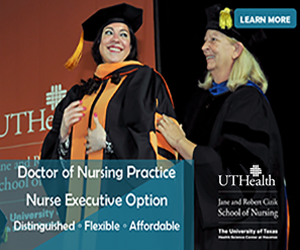 |
||
| Archive | Subscribe | Print Friendly | Send to a Friend | www.tonl.org | ||
|
||
|
TONL News & Updates
By Vicki Brockman
Joy...what does this word mean to you? During the Christmas season, we tend to think of Christmas carols or the joy on a child’s face on Christmas morning. But what does joy mean to us as leaders in our daily work? The responses will be mixed, as each of us has a different perspective of joy based on our unique experiences.
We are looking for nurses to complete a 15-minute online survey on their knowledge of the palliative care competencies. The goal is to identify the high priority palliative care educational needs of nurses in Texas and to develop educational offerings.
The purpose of this Doctor of Nursing Practice Scholarly Project is to assess attitudes toward leadership and decision-making styles of Central Texas healthcare executives. This project will utilize an anonymous, Likert-scaled, web-hosted survey comprised of 97 questions: 17 demographics, 20 fit-of-position questions, 30 leadership style and 20 decision-making. The survey will be distributed via anonymous link to the membership distribution lists of the Central Texas chapters of American Organization of Nurse Leaders (AONL) and American College of Healthcare Executives (ACHE). Data will be analyzed and manuscript developed for submission to ACHE’s professional journal. The study will be open for responses through January 31, 2020; click here to participate. The purpose of this research is to understand if a relationship exists between nurse manager emotional intelligence and staff nurse turnover on their units. Click here to participate. Nursing Leadership
By Lisette Hilton, Nurse.com
A recent search showed the Office for Civil Rights was investigating 548 such breaches in the last 24 months. These included health information breaches at hospitals, cancer centers, hospice facilities, group practices and more. Perhaps as concerning as the rate at which these healthcare cyberattacks occur is the lack of cybersecurity training at U.S. healthcare facilities.
By Jennifer Thew, RN, HealthLeaders Media
Close to 30 nurse executives gathered this week in Ojai, California, as part of the HealthLeaders 2019 CNO Exchange, to share how they are addressing pressing issues facing the nursing profession. Workplace violence and retaining experienced nurses were top of mind for participants.
By Stephanie Pavol, Cardinal Health
According to the National Institute for Occupational Safety and Health (NIOSH), about 8 million U.S. healthcare workers are potentially exposed to hazardous drugs, including pharmacy and nursing personnel, physicians, operating room personnel, environmental services workers, and others. Major changes are coming for healthcare facilities nationwide as updated standards related to hazardous drug handling become official on Dec. 1.
By Anuja Vaidya, Becker's Hospital Review
Flexibility and work-life balance have the biggest influence on a nurse's decision to remain on the job, according to a 2019 AMN Healthcare survey. The survey includes 19,967 responses from registered nurses in the United States, collected between March 27 and May 1.
Education and Events
Healthcare Industry
By Michele Wojciechowski, Minority Nurse
When vaping first began, many smokers saw it as a godsend: if they couldn’t quit, they could take up vaping, which wasn’t as toxic as smoking. Or so they thought.
By Rolando Hernandez, Texas Observer
Rural Americans bear the brunt of the country’s doctor shortage - and in Texas, home to the largest rural population of any state, it’s especially acute. More than one-fifth of Texas’ 254 counties have only one doctor or none at all. In 2018, Texas had about 54 primary care physicians per 100,000 people - one of the lowest ratios in the country, far below the national ratio of 76 per 100,000.
Practice and Patient Care
By Michele Wojciechowski, Minority Nurse
As a nurse, being able to communicate effectively with patients is crucial. But communicating with patients who have developmental disabilities may be more difficult at times. Georgia Reiner, risk specialist at the Nurses Service Organization (NSO), knows how to interact with these types of patients and answered questions on what you can do to communicate with them better.
By Lisette Hilton, Nurse.com
The U.S. veteran population was about 20.4 million strong in 2016, according to a Fact Tank blog published by Pew Research. As such, nurses in all practice settings likely will have veteran patients - many of whom have special healthcare needs.
By Jennifer Thew, RN, HealthLeaders Media
Healthcare organizations hoping to improve care of older adults may benefit from participation in the Nurses Improving Care for Healthsystem Elders (NICHE) program. A recent analysis of the program found it improves older adult care, including fall prevention, patient safety and quality of care, reduction of potentially inappropriate medications and support of healthcare providers to care for patients with dementia.
By Koren Thomas, DailyNurse
The anti-vaccination (“anti-vaxx”) movement is a global phenomenon that has received a great deal of press, but how much do we really know about it? How do educated adults come to turn against medicines that have been saving literally millions of lives since the early days of smallpox inoculations?
Members in the News
|
||


